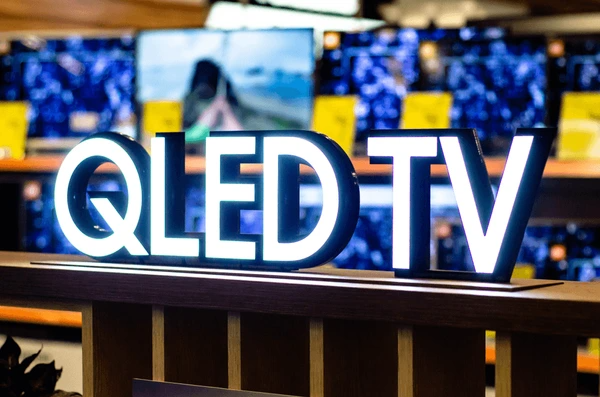
Overview of QLED vs. LED
QLED vs. LED are two popular display technologies used in modern televisions and monitors. While both offer high-quality visuals, they differ significantly in terms of technology, performance, and application. Understanding the differences between QLED vs. LED can help you make an informed decision when choosing the right display for your next device.
What Is LED and How Does It Work?
A light-emitting diode (LED) is a semiconductor device that emits light when an electrical current flows through it. This occurs when electrons recombine with electron holes in the semiconductor material, releasing energy as photons, which we perceive as light.
Working Principle of LEDs
- Semiconductor Material: LEDs are made from semiconductor materials like gallium arsenide or gallium nitride. The specific material determines the color of the emitted light.
- Electron-Hole Recombination: When a voltage is applied, electrons recombine with holes at the semiconductor junction, releasing energy in the form of light.
- Light Emission: The color of the emitted light depends on the energy band gap of the semiconductor material. Different materials produce various wavelengths, resulting in different colors of light.

What Is QLED and How Does It Work?
QLED (Quantum Dot Light Emitting Diode) uses quantum dots as the light-emitting element. Quantum dots are tiny semiconductor nanocrystals that emit light at specific wavelengths, depending on their size and composition. This unique property allows QLEDs to produce a wide range of colors with high precision.
Working Mechanism of QLED
- Quantum Dot Layer: This core component emits light. Quantum dots, typically made from materials like cadmium selenide (CdSe), can be engineered to emit different colors by adjusting their size and composition.
- Electron Transport Layer (ETL): The ETL injects electrons into the quantum dot layer. Materials like zinc oxide (ZnO) are commonly used due to their excellent electron transport properties.
- Hole Transport Layer (HTL): The HTL facilitates the injection of holes (positive charge carriers) into the quantum dot layer. Efficient charge injection into the quantum dots ensures optimal QLED performance.
- Emissive Layer: This layer contains the quantum dots. When electrons and holes recombine, they emit light that creates images on the display.
- Cathode and Anode: These electrodes supply the voltage needed to drive the QLED. The anode typically uses transparent conductive material like indium tin oxide (ITO), while the cathode uses metals like aluminum.

Key Differences Between QLED and LED
Emissive Layer Differences
- QLEDs: In QLEDs, quantum dots serve as the emissive layer. These nanoscale semiconductor particles emit light when excited by an electric current. As a result, QLEDs offer bright, saturated colors with a wide color gamut and excellent brightness.
- LEDs: Traditional LEDs use inorganic semiconductor materials like gallium arsenide (GaAs) or organic materials in OLEDs. While LEDs provide bright light, they may not deliver the same level of color purity and gamut as QLEDs.
Material Composition
- QLEDs: Quantum dots in QLEDs are made from materials like cadmium selenide (CdSe) or indium phosphide (InP). These materials are tunable, allowing for precise control over the emission wavelengths.
- LEDs: LEDs typically use bulk semiconductor materials or organic compounds. The emission wavelength in LEDs is determined by the bandgap of the material used.
Efficiency and Stability
- QLEDs: Quantum dots in QLEDs offer high luminous efficiency and stability due to the quantum confinement effect. However, they can degrade over time, which may impact performance.
- LEDs: LEDs are efficient and stable, but they often fall short of QLEDs in terms of color purity and gamut. Heat dissipation and material quality can limit LED efficiency.
Manufacturing Process
- QLEDs: QLEDs involve more complex manufacturing processes, like sol-gel processing or inkjet printing. These techniques allow for precise placement of quantum dots.
- LEDs: LED production typically uses simpler processes, with well-established methods for bulk semiconductor materials or organic layers. The manufacturing of LEDs is more scalable and cost-effective.
Applications
- QLEDs: QLEDs are ideal for applications that require high color accuracy and wide color gamuts. This includes displays for TVs and smartphones, as well as lighting applications where color tuning is important.
- LEDs: LEDs are versatile and widely used in general lighting, indicator lights, and displays. Known for their efficiency and long lifespan, LEDs serve a variety of practical applications.

Cost Considerations: Is QLED Worth the Extra Price?
Manufacturing Costs and Efficiency
QLEDs are cost-effective to manufacture while offering exceptional color quality and efficiency. Quantum dots, the semiconductor nanoparticles used, provide high-efficiency emission and long lifetimes. Techniques like inkjet printing reduce costs further by enabling large-area and flexible displays.
Performance and Longevity
QLEDs excel in peak luminance efficiency, luminous power efficiency, and operational lifetime. Current devices achieve peak luminance efficiencies over 50 cd/A and luminous power efficiencies above 20 lm/W. They also have operational lifetimes exceeding 300 hours at 1,000 nits, showing high reliability and low maintenance costs.
Applications and Market Potential
QLEDs offer versatility for various applications, from consumer electronics displays to automotive and medical devices like photodynamic therapy (PDT) light sources. Their broad applicability justifies the additional cost, given the diverse market opportunities and innovation potential.
Material and Structural Innovations
Advancements like Cadmium-free QLEDs and core/shell quantum dots have addressed material toxicity and efficiency concerns. These innovations enhance safety and performance, further improving the overall value of QLEDs.
Comparison with Other Technologies
QLEDs provide better efficiency and stability than traditional OLEDs. While considering competing technologies, QLEDs’ superior color purity and brightness often outweigh other factors, making them a smart investment for high-performance applications.

To get detailed scientific explanations of QLED vs. LED, try Patsnap Eureka.

